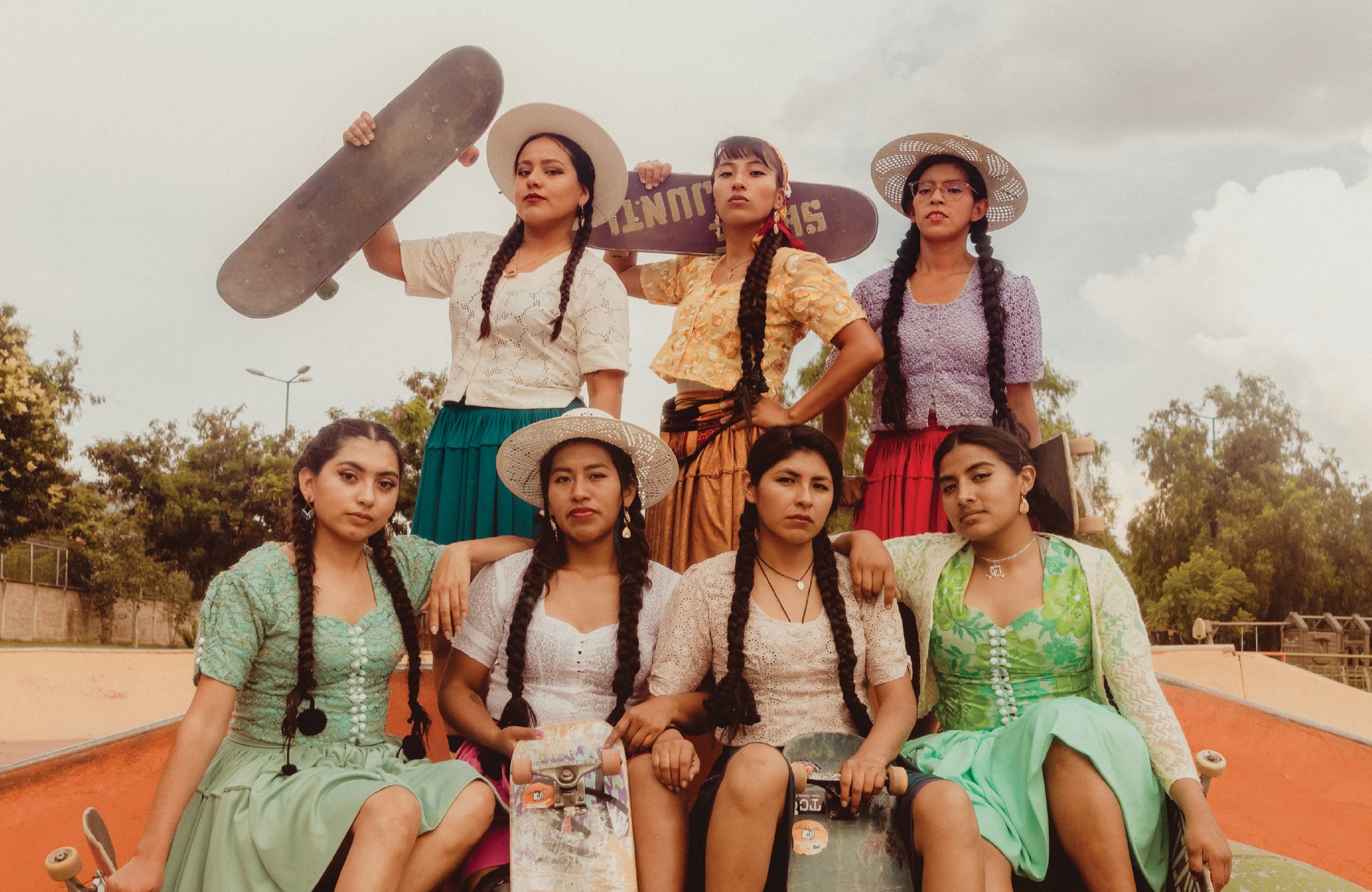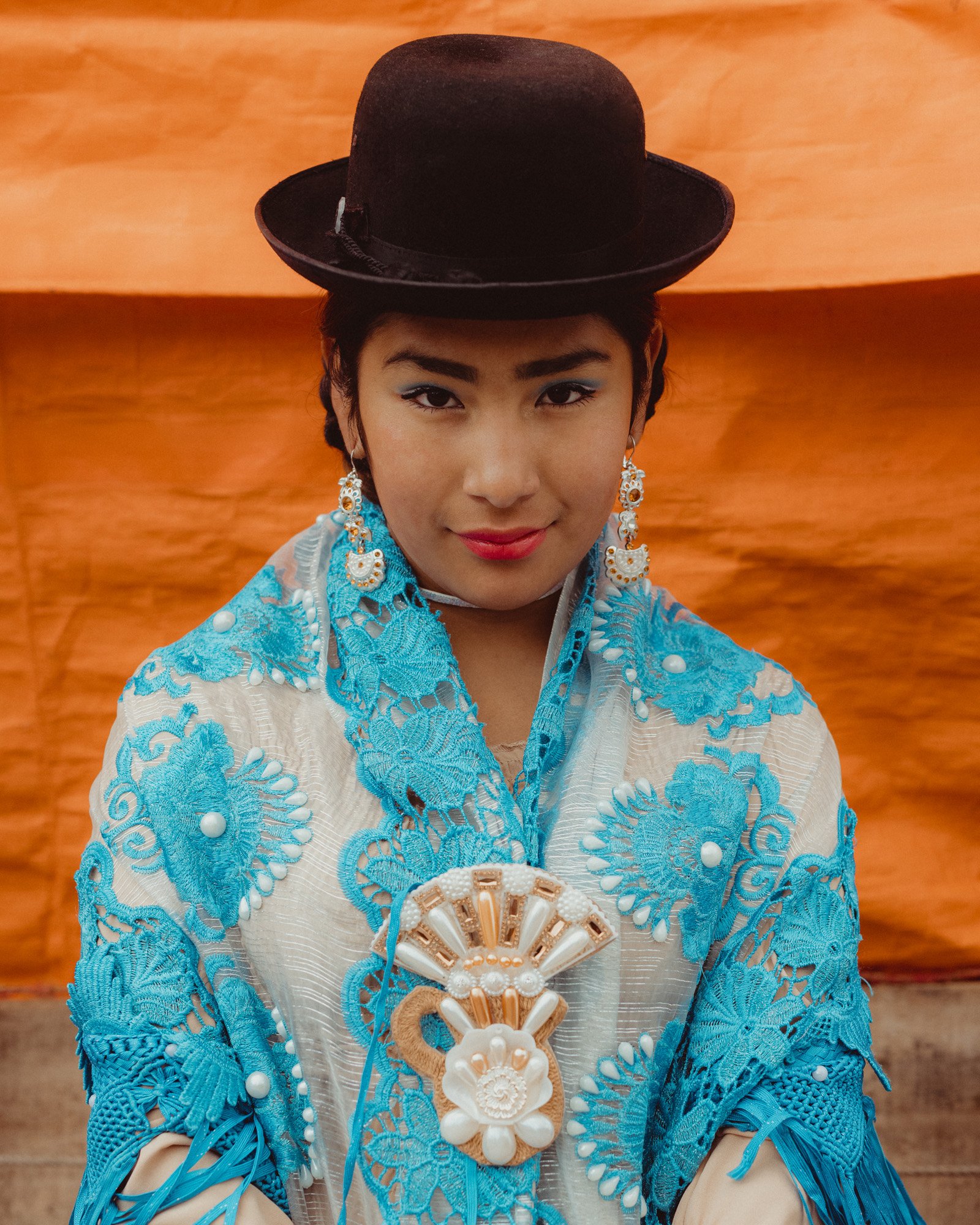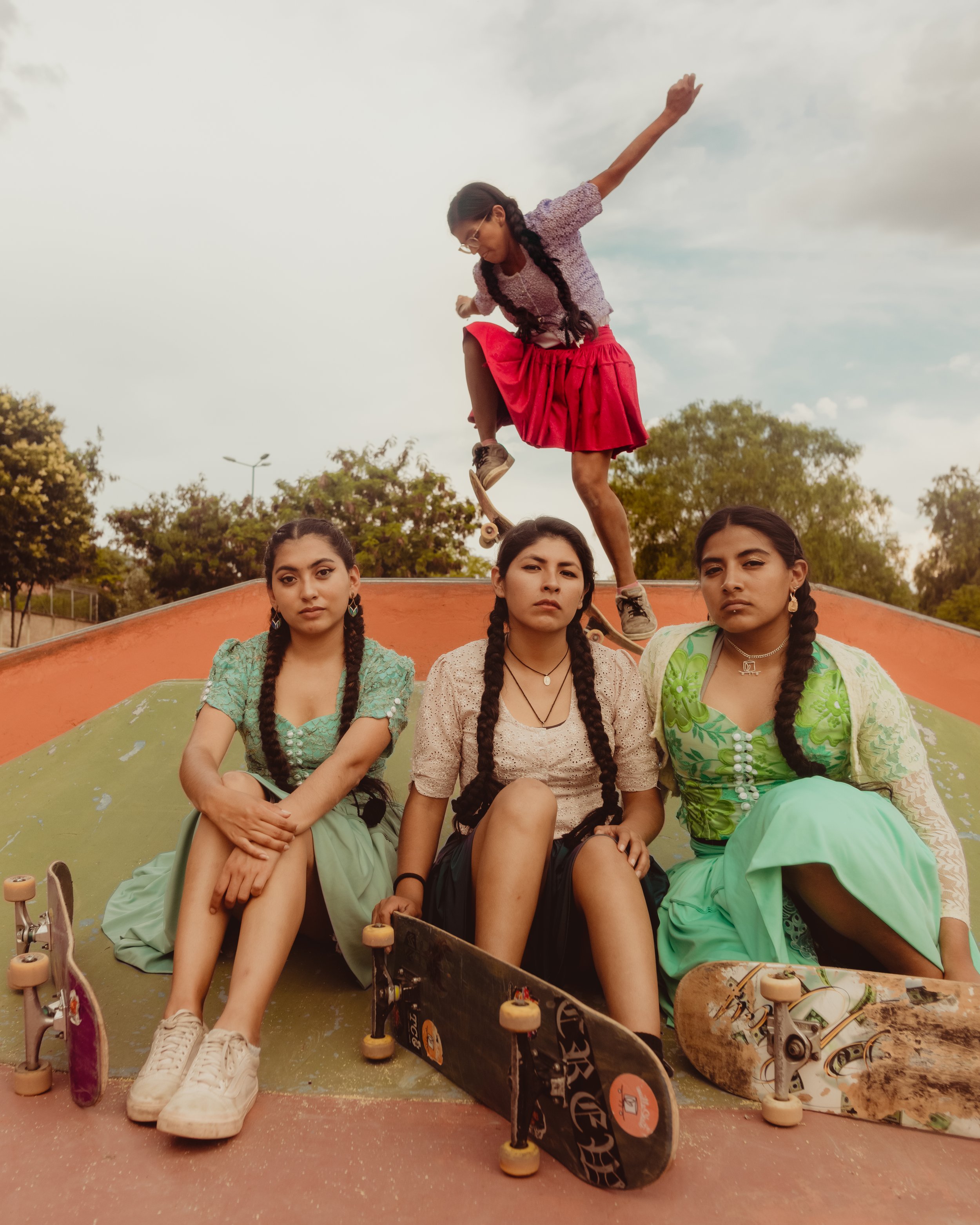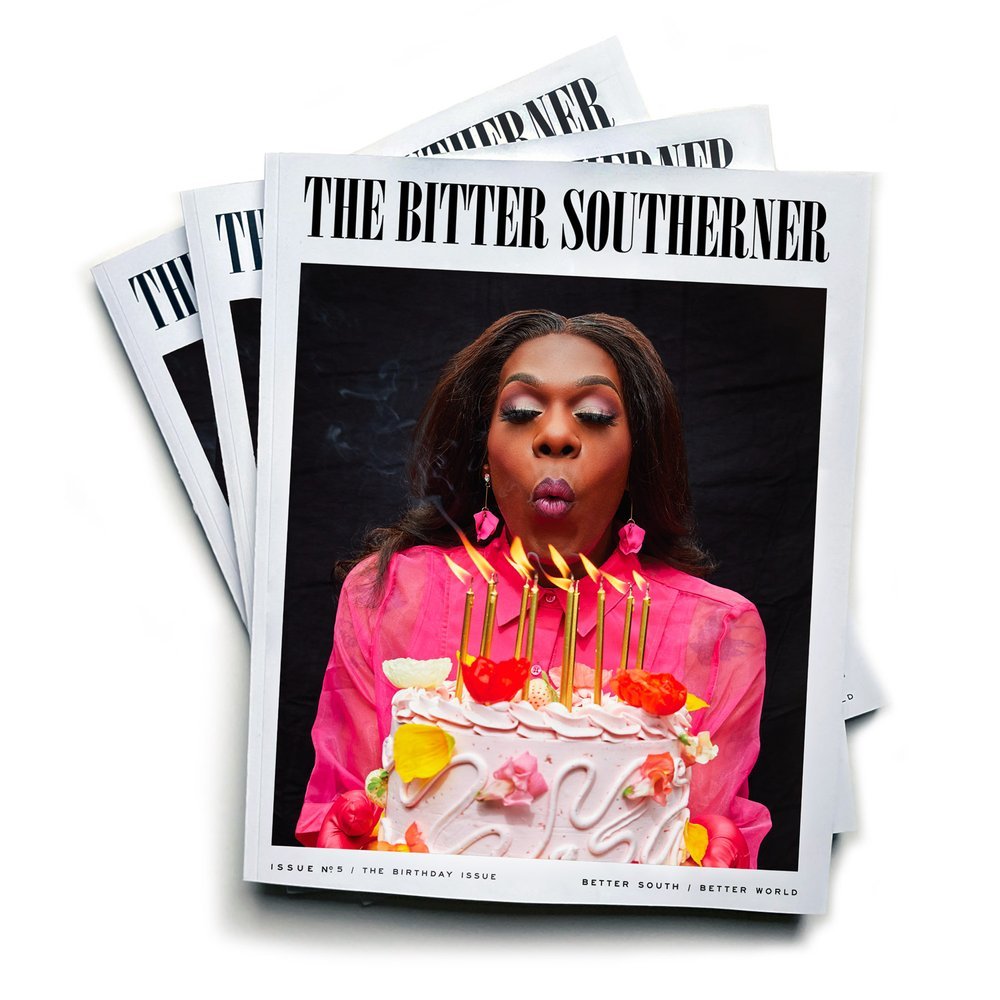The Peruvian-born, Miami-based artist Celia D. Luna traveled to Bolivia for her breakout “Cholitas Bravas” series. Her subjects climbed mountains, dominated skateparks, and wrestled both stereotypes and actual opponents.
Story by Gabrielle Calise | Photos by Celia D. Luna
May 2, 2023
The Cholitas Luchadoras, wrapped in the shawls of their ancestors, swaggered into the ring. One balanced a bowler hat atop a tightly wound updo; another made a show of shedding her long earrings before the brawl. But it was the long Andean pollera skirts that stood out across the old gymnasium — layers unfurling like an opening flower as the women soared through the air. They took turns ricocheting off the edge of the ring, grabbing female foes by the braids and slamming male rivals face first into the mat. The crowd of 100 or so howled.
Celia D. Luna watched the tussle through the viewfinder of her camera. In March 2022, she had left her home in Miami’s Little Havana to document the Cholitas of Bolivia. Once used to belittle young Indigenous women, the term “Cholita” has been reclaimed in Bolivia as a badge of honor. In Celia’s native Peru, the stigma remains. Perhaps her photographs can change some minds.
Her three-part “Cholitas Bravas” project echoes themes found throughout much of her other work: women both tough and beautiful, showing off their culture. Aside from the badass wrestlers, her images depict skateboarders flying across a pastel-hued park and a pack of hikers trudging up the side of a mountain, all swathed in brightly colored Indigenous clothing passed down over generations. As a fashion and portrait photographer, Celia loves to show how clothing tells a story.
“I want people to know you can be proud of your roots and embrace your heritage,” she said.
Celia, 41, grew up as the only child of a single mother in the Andean city of Ayacucho, Peru. Her favorite childhood memories involved traveling with her mom, Celia Morales, and taking in the region’s color: vendors slinging sweet Peruvian corn snacks, rows of pastel casitas, and folk art everywhere. Inspired by local textile makers, Celia fashioned outfits for her Barbie doll out of toilet paper and fabric scraps.
She moved to Miami for high school with her mother and later majored in graphic design. A film photography class moved her to bring her camera to every party and social gathering.
“Everything was so big — the ocean was there, and the cruise ships,” she said. “I was mesmerized.”
Boredom crept in during her eighth year as a graphic designer. When a friend asked Celia to shoot boudoir photos in 2014, she said yes.
“It was terrible,” Celia said with a laugh. “I look back at the photos and I feel like I need to pay her.”
But her subject ended up loving the shots, so Celia kept shooting. She booked weddings, then realized she hated all the ivory dresses and flowers — but loved capturing emotion on the faces of the brides.
Cholitas Luchadoras Rosario (left) and Maria José, both in their 20s, outside the gymnasium where the group spars. The matches were inspired by Indigenous women who’d learned to wrestle as a defensive tactic after surviving domestic abuse. When onlookers saw them practice in their traditional garments, it attracted attention and led to the performances put on by the Luchadoras that draw tourists to El Alto and La Paz today.
Women’s stories, like her single mother’s and her daughter’s, called to her. She took on the artist name Celia D. Luna, using her first name and middle initial, which stands for Daria, as well as her daughter’s name, Luna. Her logo, an eye in the center of a rainbow flower, was plucked from a childhood memory: watching women in Peru hand-embroider petals onto clothing.
Inspired by artists like Tim Walker, who used fashion photography to weave a narrative, Celia’s dreamy portraits show characters like a tropical Marie Antoinette lookalike on roller skates, saturated with joyful pops of color. Soft warmth radiates from her images, in living color, like afternoon sun dancing on the skin.
During the pandemic, when she couldn’t go out to shoot, she started a self-portrait series based on the alphabet, with words beginning with different letters being submitted by her Instagram followers. She took turns posing in costumes, bathed in light, embracing her lover in a circle made of flowers. Celia even dug matching Peruvian Carnival outfits out of her closet to wear alongside her daughter and mother, and photoshopped them inside a retablo box — one of Peru’s most famous pieces of folk art.
Portraits of entrepreneurs and shoots for fashion brands paid the bills. But it was the surreal projects that set her apart.
Then she met the Cholitas.
Cholitas Luchadoras Rosario and Maria José and skater Zusan are among the Indigenous women reclaiming the term “Cholita” as a badge of honor.
On a gray afternoon, Celia wound through the streets of El Alto, Bolivia, dizzy from the 14,000-foot elevation, to find the Luchadoras.
She’d discovered the wrestling Cholitas through Instagram. In the mid-2000s, Indigenous women who had survived domestic violence learned to wrestle to regain their power and fight back. When folks saw them practice in their traditional garments, it attracted attention and led to the Cholitas Luchadoras’ performances. These days, international tourists fly to El Alto and La Paz just to watch the Cholitas Luchadoras, or wrestlers, skirmish.
A scan of Instagram’s Cholita hashtag drew Celia to other women doing extreme sports. Something about these women so close to her home struck her. She needed to meet them.
Before she even had all the subjects lined up, she booked two plane tickets: one for her, and one for her mother-turned-personal-assistant. A week for three photo shoots in two cities. She would stay in La Paz, Bolivia, and travel an hour to nearby El Alto via aerial cable car and taxi.
Cochabamba, Bolivia, is the home base of imillaSkate, a group of skateboarding Cholitas who’ve been featured in National Geographic and on ESPN.
María José and Rosario, both 20, met Celia outside an old gymnasium. They were dressed to fight, in hand-beaded shirts and shawls, winged eyeliner, and smears of blue eyeshadow. Celia, always on the hunt for color, fashioned a backdrop out of orange and yellow tarps from the fruit market across the street.
Then she headed inside to take in the spectacle alongside the tourists. The air was heavy with the smell of hot popcorn, the bass of Latin music pumping over speakers, and anticipation. The Cholitas appeared, swaying their hips and swishing their skirts, to hype up the crowd. Celia couldn’t help but root for her subjects from behind her camera.
In Cochabamba, 45 minutes away by plane, she met seven skateboarding Cholitas. The group, called imillaSkate, gathered with Celia and her mother before the shoot for a meal.
Over a platter of pique macho, a Bolivian dish of beef, fries, boiled eggs, and vegetables, the women swapped stories. The skateboarders, all in their early to late 20s, had become famous in their city, featured in National Geographic and on ESPN. Celia had learned to roller skate during the pandemic, and even brought her skates to Bolivia to keep her practice streak going. Like the women in the group, she’d also dealt with pushy men at the skateparks.
“It’s such a life-changing skill for [the women],” she said. “It brought them so much joy, having to learn something, falling, getting up again. How life is, really.”
Estefanny is one of the skaters Celia D. Luna met and photographed.
Standing on the side of a small mountain overlooking El Alto, Celia had a bird’s-eye view of the city below. But she was more concerned with the wrinkle of black clouds curling above the skyline.
There had already been a struggle just to get to the second shoot. After messaging a group of well-known female climbers on WhatsApp, Celia had managed to build trust with her prospective subjects by sharing her own story. She promised to honor the Cholitas Escaladoras, or climbers, with her photos.
Ideally, Celia would have hiked alongside them on a tall mountain, far from civilization. But once she arrived in Bolivia, her contact stopped responding. Celia cried. Finally, the husband of one climber responded. His wife was filming a documentary, but their daughter could meet Celia on one of the smaller peaks closer to the city.
Seeing the sky before the shoot, Celia remembered a story someone had told her once. Blow to the clouds if your birthday is coming, and you could use your power to stop the rain. She was desperate, and celebrating a birthday soon, so she puffed.
Four women and an adorable 5-year old girl, who hikes with her mom on the weekends, posed for her. They were shy at first, unsure how to move their bodies. Celia and her mother chatted with her subjects to help them loosen up. Then Celia moved swiftly, capturing their confident expressions, their blood-orange helmets and skirts, their grace. After her last shot, the sky opened up.
After connecting with the Cholitas Escaladoras on WhatsApp, Celia made plans to meet up with them when she was in Bolivia. Though the original plan of hiking alongside them far from civilization had to change at the last minute, she was able to gather with a small group of the hiker Cholitas.
After Celia got home, she spent her days dancing on roller skates in her living room, thinking back on the trip but avoiding the images. She was afraid. What if no one got her work or appreciated these women like she did? What if all that stress had been for nothing? Instead of editing the photos she’d made, she sliced up pictures at her desk to make collages and sculpted props for her new shoots.
Four months later, she finally clicked through the images on her computer. Seeing the women onscreen, their strength and their grace, she wept.
“It was part of a sacred project,” she said, eyes tearing up even a year later. “Also, it was hard AF.”
When Celia finally posted some images on Instagram, the response was quick. People loved it. Little by little, other accounts shared the photos. Then came the press: Shoutout Miami. Colossal magazine. Now This.
It was the personal messages that touched Celia the most, like the father hoping to purchase prints for his biracial daughter so he could hang up artwork that she could see herself in; or the adopted skater born in Peru who wanted to let her know that the photos inspired him to explore his roots.
“When I was younger, there was not any representation of diversity. When I became a photographer, it was my mission to change that,” Celia said. “It’s important for my daughter to see that. I want her to identify with the people in the photos, too.”
imillaSkate’s Belu (left) and Brenda (right) take a break from being badass and pose for their portraits.
She still thinks about the Cholitas often, mostly because the series is still spreading. She’s even working on a book proposal about that week with them, and how it changed her. Her recent journeys abroad, especially meeting the Cholitas, have inspired her to pursue a more nomadic approach to life and work.
There is uncertainty about the next chapter of her life. She hopes for fewer commercial projects (“because I feel like it’s messing up my drive for creativity”) and more looking inward. But her family life is in flux. After a decade renting the same house, Celia now has to find a new home after her landlord needed the property for personal reasons. She wants to keep her home base in Little Havana and hopes to document the vibrant neighborhood before gentrification claims too much of its charm. Her 18-year-old daughter is about to head to school abroad. Her mother, now 70, is planning a return to Peru to build a house.
“It’s a lot of changes we’re going through right now, and we’ve got such a strong bond that it’s exciting but terrifying,” she said.
She planned an entire shoot based around the three of them at the beach, to honor this moment in time. That’s how she processes life: with a camera in her hand, documenting the women she admires.
Gabrielle Calise is a Florida-based culture writer obsessed with offbeat stories and nostalgia. She is the editor and creative force behind A24's 547-page travel book, Florida! A Hyper-local Guide to the Flora, Fauna, and Fantasy of the Most Far-out State in America. Gabrielle currently reports on local history, music, and shenanigans for her hometown paper, the Tampa Bay Times.
Celia D. Luna is a visual artist who specializes in portrait photography. She had a culturally rich childhood immersed in the Andean folklore and traditions of rural Peru. This colorful and magical landscape shaped her approach to photography and fashion. Celia brings diverse cultures and powerful women to life through her narrative approach to photography. She currently resides in Miami, a city whose multicultural influence continues to shape her evocative style.















